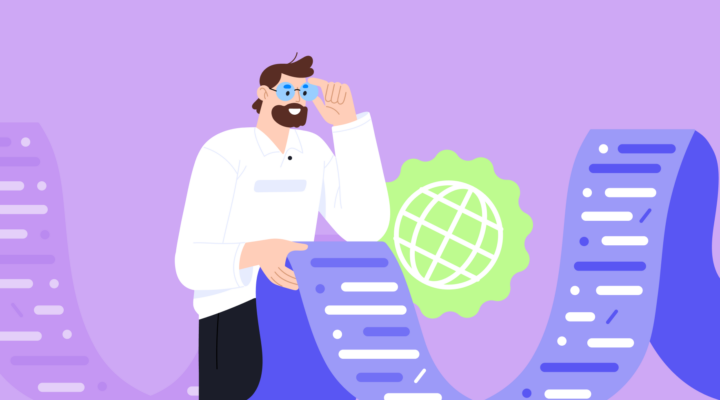Understanding Google’s algorithms allows you to apply this knowledge to grow your website and reach your ideal target audience. In this post, you will learn what Google’s algorithms are and how to optimize your travel blog for increased search visibility.

What Are Google’s Algorithms?
Understanding Google’s algorithm will help optimize your content and allow you to rank higher on the search results. With so many sources of information available, finding the best answer to your question might be tricky. To help users sort through online pages and return the best query, Google designed its search algorithm.
The Google Search Algorithm is a set of rules that the search engine follows to rank online content. This algorithm includes millions of lines of code on numerous servers around the world that are continuously adapting to the search behavior of users. To understand how Google Search works, watch this short video by Google.
Essentially, search algorithms consider many different factors, such as your search query, page’s relevance and readability, backlinks, internal links, page speed, source’s authority, geolocation, user engagement, and much more. It also depends on your query, which effects what Google will display in the first place. For example, if you search for news, the engine will prioritize the latest sources.

Image Source: First Page Sage
Google is constantly improving its systems via testing, evaluating its search results, and updating its algorithm to deliver the most relevant results to the user. Google’s algorithm updates are released daily, while major updates are released a few times per year. Even though the company does not disclose the exact ranking factors, following these updates allows webmasters to grow their positions on Google and drive more traffic to their websites.
Here’s what Lisa Garrett, travel blogger at Travel to Lyon and Waves and Cobblestones, has to say about Google’s algorithms:

Google is constantly rolling out updates to its algorithms. You may find your site — or certain posts — to be positively or negatively impacted as the algorithm changes. It’s important to realize that blogging is a continuous learning process and a long journey to success.
Know what has worked for you in the past, but understand that those factors might not be the recipe for future success.
If you were negatively impacted by an algorithm update, it’s key to objectively look at your content and evaluate what may be lacking between your post and ones that are now higher-ranking in the Google search results.
Maybe you need to remove fluff from your introduction, add a map to your post, or get to the point more quickly to answer user intent. Then work on improving your content so that it closes any identified gaps. And, don’t overlook earning more backlinks to your posts to boost their page authority.
Google’s Biggest Algorithm Updates
Chasing every single algorithm change that Google makes might be overwhelming, but it is useful to be aware of core updates. Search engine optimization is constantly developing, so to stay afloat, you need to keep an eye on Google’s major changes. In addition, understanding Google’s algorithm updates is important, as it can help you discover how the search engine thinks and which factors remain relevant throughout the years.
Here is a more detailed explanation of the key updates to Google’s algorithm over the past decade:
2009-2010 – Caffeine
To discover new content faster, Google released the so-called Caffeine update. This brought about a change in the indexing system that allowed the search engine to improve its “indexing speed, accuracy, comprehensiveness, and other dimensions.”
2011 – Panda
With Panda, Google filtered out low-quality and thin content, pages with too many keywords, as well as duplicate posts. By reducing the rankings of pages that bring no value to users, Google changed the search results for about 12% of queries. Rolled out in 2011, the Panda update is continuously implemented by the search engine on a regular basis.
2012 – Penguin
In 2012, Google released the Penguin update to block all spam links. This update was designed to discover links that are not relevant, low-quality, or simply spammy, and penalize the sites hosting them. Penguin is considered one of the most well-known updates to Google’s algorithm.
2013 – Hummingbird
In the following year, Google changed the way it treated search queries. While before, the focus was on exact keywords, the Hummingbird update shifted the focus to topics instead. From that moment forward, Google stopped matching words in a search query to words on the entire page. This allowed the search engine to better process conversational keywords.
2014 – Pigeon
The Pigeon update was designed to make local search results more relevant and higher quality.
2015 – Mobile Update and RankBrain
In 2015, Google’s algorithm started to favor mobile-friendly webpages in its mobile search results. This was known as the Mobilegeddon update. For example, the search engine prioritized pages with readable text that didn’t require users to zoom in. Soon after, Google launched mobile-first indexing, which made the overall mobile friendliness of a webpage one of its primary ranking factors.
The same year as Mobilegeddon, Google integrated the machine-learning component RankBrain into its search engine to improve the relevance of search results. This update allowed Google to discover related terms and ideas.
2017 – Fred
In 2017, Google rolled out another update to identify all bad-quality and spammy content violating the guidelines of the search engine.
2018 – Medic
Medic was a core update to the algorithm focused on YMYL webpages. YMYL stands for Your Money Your Life and, with this term, Google defined content that could affect users’ wellbeing, health, financial stability, or safety.
2019 – Bert
BERT is the name of a natural language processing model that Google uses to better understand the context of search queries as well as the word order within queries. The update affected search rankings and featured snippets. Google called Bert the biggest update to be rolled out within the last five years.
2021
Even though there have not been any major updates since 2019, some smaller changes have been implemented. For example, in April 2021, Google rolled out an update to reward product reviews with detailed research.
What Is EEAT?
Any understanding of Google’s algorithm would be incomplete without discussing EEAT (Experience, Expertise, Authoritativeness, and Trustworthiness). EEAT is part of Google’s Search Quality Rater Guidelines, which are designed to identify high-quality, authoritative pages and deliver more relevant search results. The guidelines were first published in 2013, the EAT (Expertise, Authoritativeness, Trustworthiness) concept was added in 2014, and the Experience component was introduced in December 2022.

Now, let’s explore what each component stands for and how you can optimize your page to make it more authoritative and trustworthy in Google’s eyes.
Experience
One of the features of the highest quality content is when it contains the author’s first-hand experience. It means that the insights were attained through practice and are authentic, especially when they are provided alongside unique photos or videos.
Expertise
Another component of quality content is expertise. Does the author have the relevant knowledge or qualifications for readers to take his opinion seriously? While, in some cases, users want to find examples from real life, in other situations, they are more likely to trust writers with professional backgrounds that are related to the topic being written about.
Authoritativeness
In addition to having knowledge about the topic in question, it is also important for a page to have high authority in the overall niche. Quality raters on Google carefully check the credibility of both the author and their project. This is especially true for medical sites and pages related to health, well-being, and mental stability. A positive indicator for Google will be links to your content from relevant authorities in the niche, meaning that they accept you as an accurate source of information.
Trustworthiness
Last but not least, the final component of EEAT is trustworthiness, which is related to the author themselves, the page, as well as the website in general. To obtain a high trustworthiness score, be sure to check the validity of information and factual accuracy, as well as link to reputable sources. If you have an ecommerce business, it is also important to provide secure checkout and transactions.
What is PageRank?
PageRank is a ranking algorithm that was created by Larry Page and Sergey Brin, the founders of Google. This algorithm checks the quality and quantity of links connecting websites and assigns a score of importance to each website accordingly. Essentially, PageRank evaluates pages on a scale between 0 and 10, where 0 is assigned to low-quality websites, while 10 represents the highest authority sources.
Notably, the PageRank is transferred by links from one page to another. Thus, the higher the PageRank a link has, the more authority it passes to the page. Simply speaking, PageRank can rank a website higher if other reputable blogs are linking to it.
To make sure that your website has a high PageRank, it is important to understand which factors influence it. Here are some to keep in mind:
- Anchor Text: Google believes that anchors sometimes describe a page’s content better than the page itself. So, if you want to rank for the keyword “how to become a travel blogger”, it makes sense to use that phrase as an anchor. The more links you connect to this anchor, the higher you can rank.
- Internal Links: Interlinking your webpages is a great SEO strategy, as doing so can help PageRank move from one page to another. This is especially useful to give value to pages that don’t have any external backlinks.
- No-Follow Links: While no-follow attributes used to prevent PageRank from passing through a link, this is no longer the case. No-follow attributes still sculp the way Google crawls your links, but they have a lesser effect.
- Click Likelihood: Google doesn’t treat all links equally. For example, links in banner ads or so-called technical links are less likely to be clicked by a user. Therefore, they receive less weight on PageRank.
There are several tools available that can help you learn about your page rank, including Google Search Console, SEMrush, Moz, and others.
Optimize Your Travel Blog for Increased Search Visibility
Understanding Google’s algorithm is crucial to work out an efficient strategy for search engine optimization. SEO is constantly changing, so to maintain a high ranking, you will have to regularly optimize your content according to the latest algorithm updates. Over time, you will also learn to anticipate trends and take informed, timely measures.
In addition, knowing Google’s ranking factors helps to relate them to your website’s strengths and weaknesses in order to focus on what is most important instead of trying to obtain an excellent score for every factor.
Gain Backlinks
Google gives a higher ranking to pages with backlinks from reputable sources in the same niche. Obtaining these links is a crucial part of your link-building process and might be one of the most important steps towards growing your website’s ranking and authority.
You can identify whether or not a backlink will make or break your site by comparing it to your rival’s backlink profile. Start by checking your page ranking with a rank checker and determine your current number of backlinks. For every keyword you want to rank for, you can check how many backlinks your rivals have. Thus, you can understand if more backlinks are needed to rank for the keyword and what sources you have missed receiving a backlink from. Some tools, such as Ahref’s Site Explorer, can show link opportunities (websites that link to your rivals and not to you).

To build a strong backlink profile, you can consider strategies, such as guest blogging, creating content that will naturally gather backlinks, etc.
Update Content
Google also checks how long ago your content was published or updated. This factor is especially relevant for queries that are related to the news. In this case, Google prioritizes content published in the last 24 hours. In other niches, the freshness of content might be less important, because good ideas can remain true for a longer time.
To understand whether or not freshness is important for your keyword, just type it into Google and analyze the SERP. For example, for the query “how to write evergreen content”, the featured post is from February 2023, which was about four months ago.

Add Relevant Keywords
Another way to optimize your travel blog for search visibility is to include your keyword on the page a few times. For example, you can add it to the title, subheadings, text itself, URL, introduction, conclusion, and so on.
However, it is important to avoid keyword stuffing. To understand how many times you can safely use a query on a page, analyze the search results for your keyword, especially on your top-performing pages.
Remember that your page should also respond to search intent and provide a detailed answer with accurate information. To learn more about search intent, watch this video from Travelpayouts Academy.
Improve User Experience
To improve your search visibility, think about the user who opens your page. Essentially, user experience (or UX) includes many factors that influence how easy it is for the user to read your page. UX encompasses your site’s page speed, ads or pop-ups, internal links, navigation, mobile friendliness, design, illustrations, and more.
If you don’t know where to start, make sure to improve your page’s loading speed first. Ideally, your page should load within two seconds for the user to remain on it. Google runs a Core Web Vitals test to determine your page speed and rank your page accordingly.
Grow Authority
Google prioritizes websites that bring value to users. This can greatly influence the rankings of each individual page. One of the most important steps to growing your niche authority is by acquiring backlinks from reputable niche sources.
Another way to build topical expertise is to create clusters of content that cover your topic in a comprehensive manner. For example, if you write about how to make money as a travel blogger, you can cover all popular strategies and then research and write about related questions, such as paying taxes as a travel blogger and so on.
Having comprehensive content and authoritative backlinks will show Google and other search engines that you have mastered the topic and are a trustworthy source of information.
How Increased Search Visibility Can Affect Your Affiliate Earnings
Regardless of how much you are earning with affiliate marketing now, this amount can easily be doubled, tripled, and so on with the right approach. You can mainly grow affiliate earnings using SEO in two ways.
First, search engine optimization allows you to naturally drive more organic traffic to your website. The more visitors you have, the more likely you are to receive clicks. Furthermore, using relevant keywords will attract your target audience and boost conversions.
Second, optimizing your website for search traffic will also improve user experience on your page. The best SEO strategies always have the user in mind and encourage marketers to make their website easier to navigate. The cooler the websites, the more likely the visitor will be to stay longer and come back later. This will improve your page indicators and help drive even more traffic in the future.
To learn more about how to boost your affiliate earning using SEO, take a free course from Travelpayouts Academy.
Conclusion
Understanding Google’s algorithm is one of the most important steps towards improving your search visibility. Even though the exact algorithm is not known to the public, Google regularly shares hints for webmasters to optimize their websites and provide users with the best answers to their questions. Regularly optimizing your content allows you to catch up with Google’s algorithm updates and improve your search visibility, traffic, and, consequently, affiliate earnings.
As complex as the algorithm is, optimizing your website is a very straightforward process. Focus on creating high-quality content with accurate information that brings real value to the user. Try to identify gaps in the niche and cover the topic from different angles so the user doesn’t have a reason to leave your page. Make sure to only acquire backlinks from reputable sources, as they directly influence your page ranking. Improve user experience on your page, so there is no unnecessary friction. These are the things that Google cares most about, and you should too.
If you want to grow your affiliate earnings with SEO but don’t know where to start, it is important to partner with reliable brands.
In the travel niche, one such platform is Travelpayouts. As the world’s largest digital partnership platform in the travel affiliate marketing niche, Travelpayouts provides access to over 100 travel brands and accounts for hundreds of thousands of affiliates around the world. You can join Travelpayouts for free and receive beautiful affiliate tools, such as banners, widgets, API, and more, to drive higher conversions.
Join the Travelpayouts partnership platform
Streamline your travel blog's financial success.
Join today



